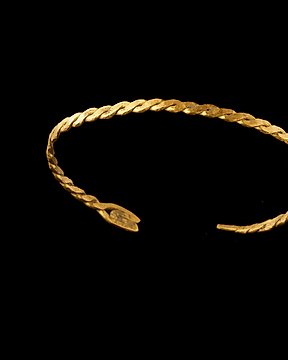
古罗马 金 手镯,公元 1 至 3 世纪。宽 4.8 厘米。重 4.26 克。
编号 83776841

编号 83776841

Ring with Telesphoros
- High Quality! -
Ancient Rome, 1st - 3rd century AD.
MATERIAL: Gold.
SIZE: Width 2 cm, 2.57 gr.
PROVENANCE: Private collection, south of France. Acquired on the Paris art market between the years 1960 - 1980.
CONDITION: Good condition.
DESCRIPTION:
TELESPHOROS (Telesphorus) was the god of convalescence who "brought to fulfillment" recuperation from illness and injury. He was depicted on ancient coins and reliefs as a boy wearing a wide cloak and low hood or Phrygian cap, and sometimes holding a scroll or tablet in his hands.
Telesphoros had his own temple, the Telesphorion (Telesphorium), in the precinct of Asklepios (Asclepius) at Pergamon in Anatolia. He was also recognised as one of the healing gods at the Asklepian sanctuary of Epidauros.
Telesphoros was also named Akesis and as such his female counterpart was the minor goddess Akeso.
The world of jewelry since ancient times has been linked to a certain status. Both men and women liked to surround themselves with luxury and make use of precious materials. However, while men introduced it into their general life, such as decorating their houses, women were the only ones who wore ornaments, with the exception of a ring in the case of men.
Roman jewelry reached a development never seen before and was not surpassed until the Renaissance. Imperial Rome was the world center of jewelry, importing large quantities of precious stones and materials.
The initial style of his works was typically Greek or Etruscan, but he soon developed his own style, ornate and ostentatious, precious stone settings, opus interassile, true mosaic of small stones on a gold or silver support. Another specialty of Roman jewelery was the carving of gems, with its coveted cuts, incisions and bas-reliefs and above all its cameos, carved on agate and onyx, stones with layers of different colors that, once polished, produced an effect of depth and depth. polychromy. His main subjects were portraits.
Notes:
- The piece includes authenticity certificate.
- The piece includes Spanish Export License (Passport for European Union) - If the piece is destined outside the European Union a substitution of the export permit should be requested, can take between 1-2 weeks maximum.
- The seller guarantees that he acquired this piece according to all national and international laws related to the ownership of cultural property. Provenance statement seen by Catawiki.
#pioneeringwomen
#ExclusiveCabinetofCuriosities